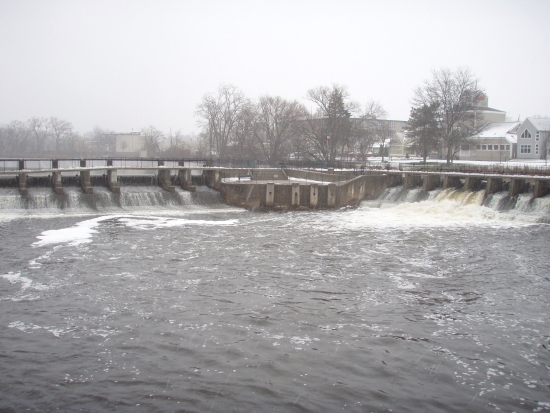Rogue River

Originally named “Rouge River”, the river’s name was altered in the 19th century due to the printing error of a Wisconsin mapmaker. As a frontier waterway, the historic Rogue River was of major importance to local tribes and traders. During the lumber era in the latter 1800s its waters floated timber to the mills of the Grand River valley, and the riverboat Algoma plied its way northward along Rogue giving its name to the Kent county township of Algoma.
Rogue River is designated as “Country Scenic” under Michigan’s Natural Rivers Act. It is popular with trout fishers and local youth who have floated the river by innertube since the mid 20th century. It is intersected in parts by the White Pine Trail. It varies from 15 feet wide in the upper sections to 80 feet wide near its end and is between 1 – 6 feet deep.
The Rockford Dam restrains the Rogue in the City of Rockford.

Rockford, MI History
The Rockford area was first visited and inhabited by Native American cultures, such as the Hopewell , Mascouten , and Ottawa peoples. There have not been archeological finds of Native American settlements in the Rogue River valley, but their trails branched through the area and were noted by early surveyors.
The first important settler of what would become the city of Rockford was Smith Lapham, who had come to Kent County in 1843 after living in Washtenaw County for 18 years. Smith Lapham came to the banks of the Rogue to assist in the completion of a dam and sawmill begun by a William Hunter. Hunter gave Lapham 40 acres of land on the east side of the Rogue for his trouble, and Lapham stayed there for the rest of his life. Hunter shortly left the area.
Lapham built his own sawmill on his side of the river, which was completed by 1844. Other settlers soon followed, including John Long, Freeman Burch, and William Thornton. By the fall of 1845, the settlement had about 5 houses. Since the settlement existed largely on land owned or sold by Smith Lapham, it became known as Laphamville. In 1856 it was first platted as Laphamville by William Thornton.
By 1865 the Grand Rapids and Indiana Railroad Company had begun a railroad extending northward through the village. The railroad had been advising the residents to adopt a shorter name, and when a newly arrived resident from Rockford, Illinois proposed the name of his former town, the new name was narrowly approved. It was replatted under the name Rockford in 1865 and incorporated as the Village of Rockford in June 1866 with 315 inhabitants.
In recent years (starting around the 1980s), the town of Rockford has developed a more suburban character as a popular bedroom community , as the Grand Rapids Metropolitan Area has grown in the past couple of decades.
Recreation
The White Pine Trail runs through the downtown area of Rockford, next to the Rogue River and the Rockford Dam. Rockford also has many small parks dotted along the river for a great place to rest while enjoying the white pine trail.
Economy
Wolverine Worldwide , a footwear manufacturer, was founded in Rockford in 1883 and has been an important employer in the area. Other light industrial, light manufacturing, and commercial business employ many in the area. Many Rockford residents work and shop in nearby Grand Rapids. It also has many small businesses that are in the area to help the economy along.
Contact Us
From individual instruction to group outings, most any request can be accommodated
View Rates